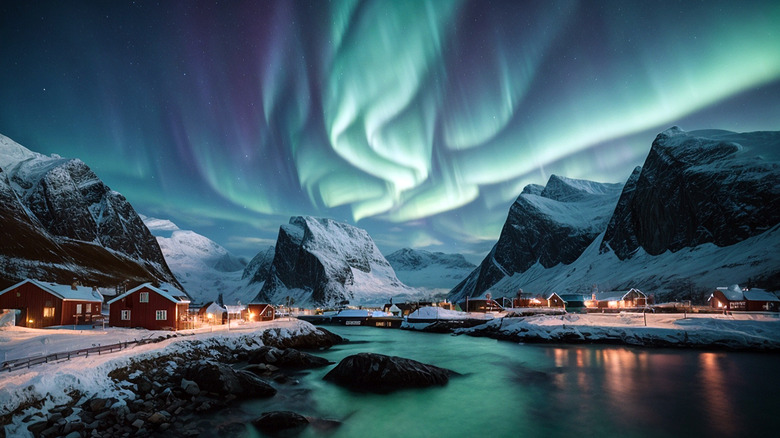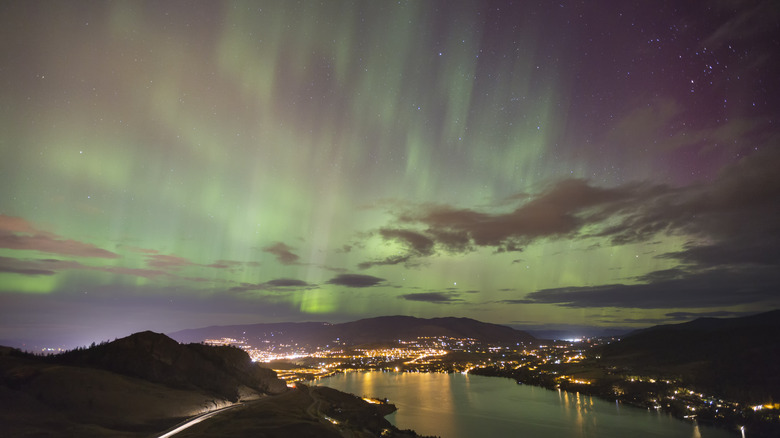The Different Types Of Northern Lights Explained
The auroras — more commonly known as northern or southern lights — are a top contender for nature's most awe-inspiring phenomenon. So captivating are these shows of light that, throughout human history, they've often served as a canvas onto which societies projected their religious, political, and social beliefs and biases. But the science behind these mesmerizing displays of color and motion is just as enthralling as any myth.
These performances of light begin on the surface of our Sun, where solar storms unleash waves of electrically charged particles into space known as the solar wind. In fact, our star's electromagnetism is one of five characteristics of the Sun that affect everything in the solar system. When these particles encounter Earth's magnetic field, some collide with atmospheric gases at the poles, causing oxygen and nitrogen molecules in the atmosphere to release that energy in the form of light. Oxygen produces the northern lights' iconic green hues, while nitrogen, the one of the most common gases in the atmosphere, can produce shades of blue, purple, and pink. During particularly energetic solar storms, high-altitude oxygen interactions can even paint the sky in dramatic scarlet reds.
But it may surprise you to learn that not all northern lights shows are the same. In fact, scientists have classified six different types of them so far, ranging from peaceful arcs stretching across the horizon to dramatic coronas that seem to open a portal to the cosmos. Each offers unique insights into the complex interactions between solar activity and Earth's magnetic field.
The classics: arcs and bands
Auroral events often begin with displays of rainbow-like curves stretching across the horizon. The most common forms that auroras take happen to be arcs, which occur when geomagnetic conditions are relatively calm. They are also the type you're most likely to witness if you're in the planet's lower latitudes.
As solar activity intensifies, however, these arcs can transform into the slightly more dynamic aurora category known as bands. These are generally pretty similar to arcs, and they resemble a kind of wavy curtain stretching across the sky. When you add in some increasing energy from a geomagnetic storm, you end up experiencing a slightly different light show; bands can often look like they're moving and bouncing as their dynamism rises in tandem with the storm's intensity.
Standing beneath these formations, observers will witness rivers of light flowing and undulating overhead — a scene that's often a sought-after prize for outdoor photographers.
Pillars and diffuse displays
Among the most striking aurora formations are pillars (sometimes called rays or beams). These vertical streaks of light appear to reach toward the stars, occasionally extending hundreds of miles into the atmosphere. Pillar characteristics occasionally show up in band and arc auroral forms as striations, adding a vertical dimension to them, and they can even appear to pulsate during high-energy displays.
In contrast to these well-defined columns of light, diffuse auroras present viewers with a more subtle, ambient spectacle. Sometimes visible as a gentle glow or cloud without distinct shapes, diffuse auroras can require specialized equipment to view properly. The term "diffuse" is also used to describe auroras of other types when their boundaries become less defined.
Interestingly, aurora types that have a discrete shape, like arcs, are created by entirely separate natural processes to diffuse displays. Arcs typically form as a result of interactions between electrons and shifts in Earth's magnetic field; diffuse northern lights are thought to originate from waves of charged particles dispersing electrons into the planet's atmosphere.
The newcomer: dunes
On October 7, 2018, photographers documented a fascinating display of auroras in the skies above Sweden and Finland. Their images depicted waves of sandy or snow-like crests stretching out toward the horizon; a team at the University of Helsinki later identified the lights as an entirely new type of aurora. Referred to as dunes for their resemblance to sandy ripples on a beach, this novel form of aurora has gained increasing attention from stargazers in recent years.
These mysterious waves of light can stretch for hundreds of miles horizontally into the sky and have come to represent a new frontier in atmospheric research as scientists work to understand the precise conditions that give rise to these wavelike formations. Currently, researchers believe dunes are formed by elevated levels of oxygen densities brought about by atmospheric waves that travel horizontally through the sky. This form of aurora is relatively rare, so the next time you're lucky enough to catch a display, have your camera at the ready.
The crown jewel: corona auroras
Of all aurora formations, none quite matches the majesty and spectacle of the corona category. This mesmerizing display takes on the shape of a vortex-like pattern composed of multiple rays of light converging on a single point overhead in the sky.
One of the most coveted types of light shows for aurora chasers and outdoor photographers, the base of the corona category of auroras begins only 50 to 60 miles above the ground (most auroras occur between 60 and 620 miles up in the atmosphere). In February 2019, photographer Jingyi Zhang captured an arresting image of a "dragon aurora" over Iceland that was featured as NASA's official photo of the day. That particular light show had its origins in a hole in the Sun's corona that launched a volley of charged particles into the solar wind, eventually reaching Earth and creating the spectacle in Zhang's jaw-dropping image.
Corona auroras are rare, only occurring at higher latitudes during intense solar storms, but they are some of the most spectacular visual phenomena that nature produces on our planet (although the rare double meteor shower might be a challenger).




